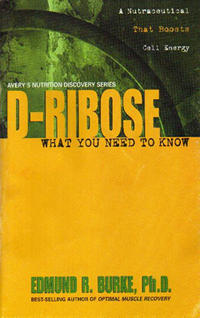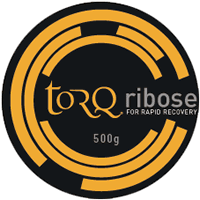There’s an amazing new supplement on the market and it’s called ‘D-Ribose’. Amazing – why? I’ve spent the last 18 months carefully examining the literature and reading every morsel of information I can find on the subject – and it appears that this little sugar will allow you to train harder, for longer and recover 300-400% quicker!!! Hence, the emergence of TORQ ribose and TORQ bar. Most of my riders have been using TORQ ribose over the winter months and have found it highly effective during periods of heavy high load training and ensuring a peak for races. If you find these claims difficult to accept, read on and I’ll convince you. There are many supplements out there that manufacturers claim will work, but don’t – this certainly isn’t one of them…
Ribose is present within every living cell of the body and is used to manufacture ATP (the energy currency of the cell) from scratch. Whilst the body can manufacture its own ribose from glucose, this requires energy and is a very slow process. Research into ribose supplementation* has proven that taking as little as 3-5grams per day will return cellular levels of ATP to normal within 6-22 hours of exhaustive exercise. Without supplementation, this is likely to take between 26 and 93 hours.
Ribose has only recently become commercially available and in the coming years I suspect that it will be as talked about among endurance athletes as creatine currently is with the strength/power performer. Ribose is the precursor to ATP (energy) production in the cell. Whereas creatine quickly recycles ADP + Pi to make ATP, ribose is actually used to manufacture ATP from scratch. The benefits of creatine, carbohydrate or any other nutrient will be seriously hampered if cellular ATP, ADP and AMP are low – and ribose is the only solution. Either wait for your body to manufacture its own or take a fast-acting supplement, the choice is yours…
Every cell in your body contains ATP (adinosine triphosphate), an energy-rich compound that provides virtually all the energy needed to function on a second-by-second basis. When ATP is broken down into ADP + Pi (adinosine diphosphate + inorganic phosphate) energy is released and this is used to power all our bodily functions. Naturally then, it is the breakdown of ATP within the cells of the working muscles that provides the energy for exercise. Without it you wouldn’t be going anywhere!
It is through the metabolism of carbohydrate, fat and protein that ADP + Pi is reformed to make ATP. This ATP is then available to be used for muscular contraction. As the muscle uses it, once again it will break down to ADP + Pi and so it goes on. When exercising, this cycle rapidly and continually takes place in order to satisfy the substantial turnover of energy required.
Research has shown that after maximal high load exercise, the pools of ATP and ADP + Pi in skeletal muscle cells are reduced by as much as 20-28 percent. The mechanisms behind this are rather complex and involve the loss of a compound called AMP (adinosine monophosphate). However, the net effect is that the overall pools of ATP and ADP + Pi within each cell is reduced, which seriously limits their energy potential. It doesn’t matter how much carbohydrate you ram into your body, if these nucleotide levels are low, you’re not going to have the raw materials available to exercise effectively. To further compound the problem, once AMP has left the cell, there’s no getting it back and so ATP and ADP + Pi levels will remain low, perhaps sinking further if another high intensity bout of exercise is experienced.

Ed Burke PhD strongly advocates the use of Ribose in his most recent book ‘Serious Cycling’ available through www.amazon.co.uk
What is ribose and what does it do?
Ribose is a simple sugar, the carbohydrate backbone of ribonucleic acid (RNA) and deoxyribonucleic acid (DNA), so is a component of the genetic materials used to pass on genetic code from one generation to the next. As well as having this very important function, ribose is also the starting point for the production of ATP. Although cells cannot draw nucleotides back into them to re-form ATP, they can make it from scratch using ribose.
Ribose is found naturally in every living cell of the body and is synthesised from glucose, but this is slow, complicated and requires energy. Supplemental ribose is able to bypass this process, quickly re-building cellular ATP and returning muscle energy levels to normal. Again, research has shown that ribose supplementation increases the manufacture of ATP in skeletal muscle by 340 to 430 percent. It has also demonstrated that ribose improves the cell’s ability to salvage and re-use ADP and AMP by as much as 700 percent (these are the nucleotides that are usually lost from the cell for good). These are not ‘slight’ benefits. They are highly significant and quite staggering.
Why supplement with ribose?
Whilst all living cells contain ribose, there is not enough in the food we eat to re-stock energy levels. Ribose in meat is predominantly lost through the cooking process and there are insufficient quantities of the nutrient in plant foodstuffs to have any effect. Add to this the fact that it can take many days for the body to synthesise its own ribose from glucose and the benefits of supplementing with this nutrient become clear. Supplemental ribose is very quickly absorbed into the bloodstream with much of this absorption occurring before it is even swallowed. Once in the muscle cell itself, ribose can be very quickly transformed into ATP.
Without ribose supplementation, research suggests that most people’s muscles will take between 26 and 93 hours (1-4 days) to return cellular ATP levels to normal after strenuous exercise. It goes without saying that this could be longer or shorter depending on how strenuous and prolonged the exercise was (this is based on a 28 percent loss of nucleotides from the muscle). With ribose supplementation, a return to full cellular energy charge would take 6 to 22 hours (within a day).
How much ribose should I take?
You’ll get full usage instructions with your tub of TORQ ribose, but we’re not talking huge quantities here. To keep cellular ATP levels at their highest, you should be taking 3 to 5 grams (1 level teaspoon) of ribose per day. During periods of low load training or prolonged recovery, it’s questionable as to whether you’ll derive any benefit from taking ribose. Therefore a 500gram tub of TORQ ribose will keep you going for about 5 ½ months (3grams per day).
Is ribose supplementation safe?
Ribose is naturally occurring in every living cell of every living creature (animal or plant) on the planet. Ribose is not a compound that’s alien to the body, but one that it recognizes and uses effectively. It is because there are no substantial dietary sources of ribose that the body needs to make its own. This is why ribose supplementation is so astonishingly effective. It’s only in the last couple of years that scientists have worked out a way to manufacture this simple sugar relatively inexpensively. There have been incidences of diarrhea in individuals who have taken exceptionally high doses (60grams per day), but this is 12 to 20 times the suggested dose.
* For further information on the conclusive research into ribose supplementation read “D-RIBOSE, what you need to know” by Edmund R. Burke, Ph.D. Avery Publishing Group (1999). Also, in Edmund Burke’s latest book “Serious Cycling” published by Human Kinetics (2002) he dedicates a couple of pages to the positive and significant properties of ribose (pp 167-169). These books are both available for order through www.amazon.co.uk.
Click here to find out more about TORQ ribose
TORQ bar also contains TORQ ribose, so click here for further information.
All TORQ products can be ordered online via our secure server here at www.torqfitness.co.uk or by calling the local-rate TORQ order hotline: 0845 125 9081 (all major credit/debit cards accepted)
© Matt Hart. TORQ 2003
Picture below: D-RIBOSE – What you need to know








